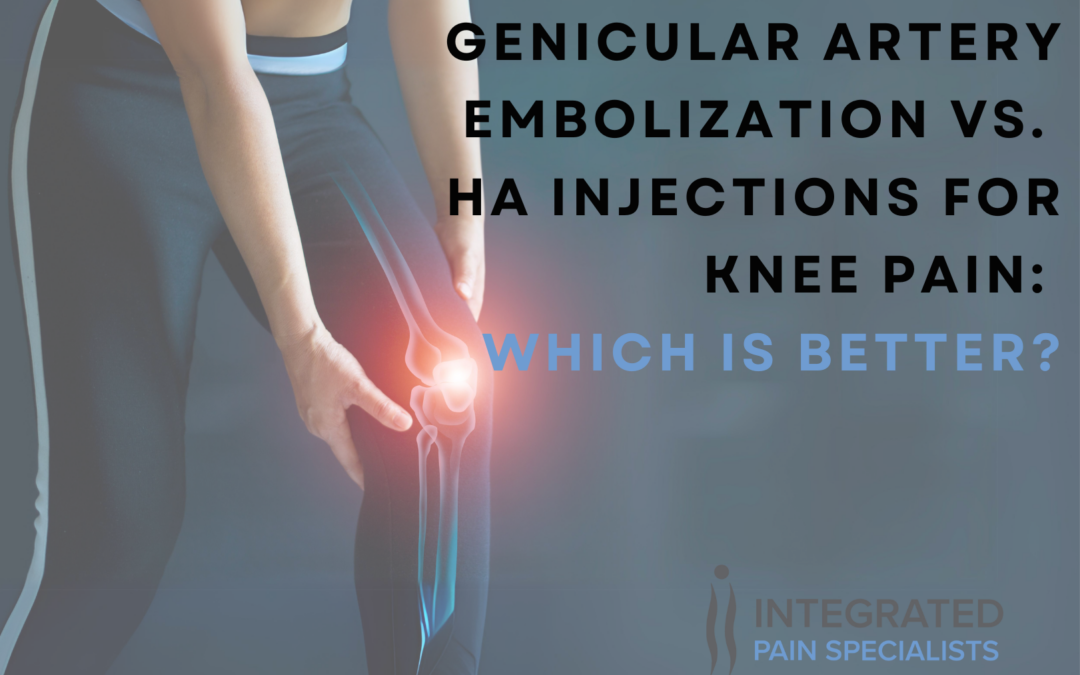Chronic knee pain is a common problem, especially for those suffering from osteoarthritis (OA). Traditionally, Hyaluronic Acid (HA) injections have been widely used to manage knee pain. However, Genicular Artery Embolization (GAE) has emerged as a revolutionary alternative, providing superior results in many cases. Understanding the differences between these two treatments is key to determining the most effective option for long-term knee pain relief.
What Are Hyaluronic Acid (HA) Injections?
Hyaluronic Acid injections are a non-surgical treatment that aims to reduce pain in osteoarthritis patients by supplementing the natural fluid in the knee joint, called synovial fluid. HA acts as a lubricant, which can help reduce friction between the bones in the knee and thus relieve pain. In most cases, HA injections are administered when initial conservative treatments, like physical therapy and pain medications, have failed.
Benefits of HA Injections:
- Non-invasive and relatively simple procedure.
- Provides temporary pain relief for several months.
- May improve mobility by cushioning the knee joint.
Drawbacks of HA Injections:
- Relief may only last for a few months, requiring repeated treatments.
- The effectiveness varies from patient to patient.
- HA injections do not target the underlying cause of knee pain, like inflammation, but alleviate the symptoms.
While HA injections provide temporary relief, they do not stop or reverse the progression of osteoarthritis, leading patients to seek more effective and lasting solutions like Genicular Artery Embolization (GAE).
What Is Genicular Artery Embolization (GAE)?
Genicular Artery Embolization (GAE) is a minimally invasive procedure aimed at reducing inflammation in the knee by blocking the small arteries (genicular arteries) that supply blood to the inflamed areas. This technique directly targets the primary cause of pain in osteoarthritis, which is inflammation. By reducing blood flow to these inflamed areas, GAE decreases pain and slows the progression of knee damage.
How Does GAE Work?
The procedure involves inserting a catheter into the femoral artery, typically near the groin, and guiding it to the genicular arteries supplying the knee. A specialized contrast dye is used to visualize the arteries, and then small particles are injected to block the blood flow to inflamed areas of the knee. This reduces the heat and swelling associated with osteoarthritis.
Why Choose GAE Over HA Injections?
While both HA injections and GAE aim to provide relief from knee pain, GAE has several distinct advantages over traditional Hyaluronic Acid injections, making it an attractive option for patients seeking long-term pain relief and improvement in their quality of life.
1. Long-Lasting Pain Relief
One of the main drawbacks of HA injections is their temporary nature. Pain relief typically lasts anywhere from a few weeks to several months, and patients often need repeated injections to maintain the benefit. In contrast, GAE offers long-lasting results. Many patients report significant pain relief that lasts for years after a single procedure. Because GAE directly targets inflammation, it addresses the root cause of osteoarthritis pain rather than just masking it temporarily.
2. Minimally Invasive Procedure
Like Hyaluronic Acid injections, GAE is a minimally invasive procedure. It is performed using a catheter and small particles to block the inflamed blood vessels. However, GAE’s targeted approach allows for more precise treatment of the knee pain’s underlying cause. Patients can typically resume normal activities within a few days after GAE, whereas HA injections may require more frequent visits to the clinic.
3. Reduces the Need for Surgery
For many patients with chronic knee pain, total knee replacement surgery may seem like the only option if conservative treatments, such as physical therapy, pain medications, and HA injections, fail to provide lasting relief. GAE offers a promising alternative that could potentially delay or eliminate the need for surgery. By reducing inflammation and slowing the progression of osteoarthritis, GAE can extend the life of the knee joint and provide years of pain relief without the need for invasive surgery.
4. Minimal Side Effects
Both Hyaluronic Acid injections and GAE are considered safe treatments with minimal side effects. HA injections, however, can cause temporary swelling, redness, and discomfort at the injection site. Some patients may also experience allergic reactions or infections. GAE, on the other hand, has been shown to have very few adverse effects, and most patients experience significant improvement in their symptoms with little to no complications.
5. Suitable for Patients Unresponsive to HA Injections
While HA injections are commonly prescribed for knee osteoarthritis, not all patients experience significant relief. For those who have tried HA injections without success, GAE offers a viable alternative. Since GAE addresses the underlying inflammation that causes pain, it can be a more effective treatment option for patients who have not responded to other conservative therapies.
Comparing Efficacy: GAE vs. HA Injections
Targeting the Root Cause: One of the most significant differences between GAE and HA injections is how they treat knee pain. While HA injections improve the joint’s lubrication to reduce friction, GAE directly targets the source of inflammation in the knee joint. This more targeted approach leads to better long-term outcomes.
Long-Term Effectiveness: HA injections offer temporary pain relief, requiring repeated treatments every few months. On the other hand, GAE has shown long-term effectiveness, with many patients experiencing relief for several years after the procedure.
Side Effects: Both treatments are safe, but GAE tends to have fewer side effects compared to HA injections, which can cause discomfort or swelling at the injection site.
Who Is a Candidate for GAE?
GAE is particularly beneficial for patients suffering from moderate to severe osteoarthritis who have not found relief from other treatments, such as physical therapy, medications, or HA injections. Patients looking to avoid surgery or those who are not candidates for surgery due to other health issues may also benefit from GAE.
Conclusion
When managing knee pain due to osteoarthritis, both Hyaluronic Acid injections and Genicular Artery Embolization (GAE) offer viable treatment options. However, GAE’s ability to address the root cause of pain through targeted reduction of inflammation makes it a superior option for long-term relief. Its minimally invasive nature, combined with long-lasting results and minimal side effects, makes it a strong alternative for those seeking to avoid surgery or prolonged reliance on temporary solutions like HA injections.
If you’re suffering from chronic knee pain and looking for a lasting solution, consider consulting with the experts at Integrated Pain Specialists to discuss whether Genicular Artery Embolization is the right option for you.
By choosing GAE, you can take a proactive step toward reclaiming your mobility and improving your quality of life without the need for surgery or frequent injections.

